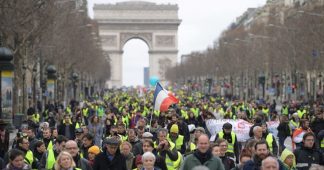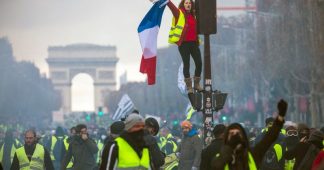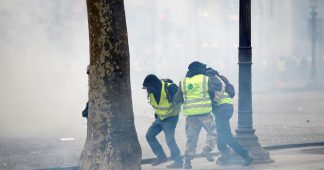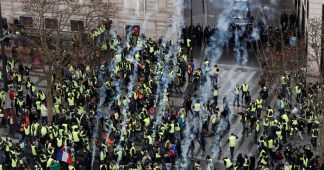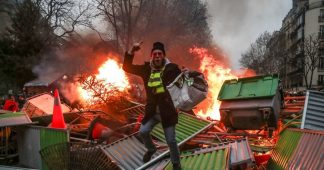By Christopher Ketcham
August 2019
When I caught up with the Gilets Jaunes on March 2, near the Jardin du Ranelagh, they were moving in such a mass through the streets that all traffic had come to a halt. The residents of Passy, one of the wealthiest neighborhoods in Paris, stood agape and apart and afraid. Many of the shops and businesses along the route of the march, which that day crossed seven and a half miles of the city, were shuttered for the occasion, the proprietors fearful of the volatile crowd, who mostly hailed from outside Paris and were considered a rabble of invaders.
Among the marchers’ goals were disrupting business as usual, halting commerce, spreading disorder, and, in doing all of these, making themselves heard. They had been in the streets every Saturday since the first Gilets Jaunes action on November 17, 2018, when almost three hundred thousand citizens gathered across France in protest of taxes and fiscal reforms they felt unfairly burdened the poor, the working class, retirees, pensioners, and the unemployed. On two Saturdays in December, as the movement escalated, they had rallied by the thousands in Paris and, in an eruption of terrific vandalism, caused millions of dollars of property damage in the world’s most expensive city. On December 1, demonstrators had rampaged through Paris’s luxury districts: on the Champs-Élysées, Avenue Hoche, Opéra, on the Rue de Rivoli, at Place Saint-Augustin, and on Boulevard Haussmann, shattering storefront windows, looting, and setting cars on fire. At Place Vendôme, home of world-famous jewelry boutiques, the Gilets piled up plastic Christmas trees and set them aflame, declaring that Père Noël, father of consumption, had come with a vengeance. In the neighborhood around Place de l’Étoile, mansions were vandalized and burned. These were the redoubts of the despised haute bourgeoisie, who lounged in ease while the rest of France languished, and riot was the answer to that inequity.
There had been much violence and much suffering since December, and not just in Paris. Citizens in Rouen, Toulouse, Bordeaux, Lyon, Nîmes, Nantes, and Nice bombarded cops with hammers, ball bearings, rocks, and cobblestones torn from the streets. The more serious among the protesters threw Molotov cocktails that set the cops on fire. There were pitched battles against the forces de l’ordre that ended with the demonstrators bloodied and driven back under a wave of truncheons. Hundreds of properties were ransacked and set on fire, with at least 2,200 protesters injured, some of them losing eyes, jaws, hands, and feet from the rubber bullets, tear-gas rounds, and dispersal grenades that police officers and gendarmes fired in enormous volumes to scatter the crowds. By mid-December, the French president, Emmanuel Macron, faced with civil unrest exceeding any since the student protests of 1968, declared a state of national emergency. “The people allude to the French Revolution,” a professor of political science at Paris’s Sciences Po told the New York Times: “ ‘We have to cut off the head of the king.’ ”
Now on March 2, the Gilets Jaunes, clothed in their yellow vests, the reflective safety gear that motorists in France are required to carry and that had become the group’s mark of solidarity, streamed along the Rue du Ranelagh. They chanted “Paris, wake up!” and a call-and-response of “Are you tired? No, we are not tired!” A few carried the French tricolor, the national flag with roots in the revolution of 1789, which they held high on long poles. Some periodically launched into a bellowing, guttural, basso rendition of the “Marseillaise,” as the Gilets did whenever they gathered. “Listen to the sound in the fields,” they sang,
The howling of these fearsome soldiers
They are coming into our midst
To cut the throats of your sons and consorts.
I was racing to join them when I passed two exquisitely dressed women who stared with worried, petulant faces as they walked their dogs in the park. One of them lived on the other side of the Rue du Ranelagh and said she dared not approach the mob. “France’s elites have not felt such fear in half a century,” Le Monde diplomatique, a left-leaning monthly newspaper, had editorialized in February, the month I arrived in Paris, “and it’s not the usual fear of losing an election, failing to ‘reform,’ or seeing their shares slide on the stock market, but fear of insurrection, revolt, and loss of power.”
By the spring, the Gilets Jaunes had morphed into a movement that broadly eclipsed their initial intent, which was to protest a modest increase in fuel taxes imposed in 2018 by the Macron government. The new carbon tax—nine cents more per liter of diesel, four cents more per liter of gasoline—may have been the proximate cause that galvanized the Gilets, but the worsening conditions of what the protesters called “l’injustice fiscale” provided the powder for an explosion.
The context was the government’s widening embrace of the doctrines of neoliberalism. A nation decried by its governing elites as creaking, slow-growth, debt-ridden, and unemployment-plagued—out of step with the freewheeling global economy—was to be liberated at last from the constraints of the social-welfare state that had been in place since the 1940s. Jump-starting the machine of growth meant, of course, cutting social spending—it meant, that is, a program of austerity for those most in need of help. The cornerstones of the peculiarly stalwart French sense of égalité and fraternité were to be loosened and perhaps eventually dissolved. This, after all, was what the European Union and the International Monetary Fund demanded of member states for the greater good of capital flow.
Elected in 2017, Emmanuel Macron—a youthful and imperious former investment banker at Rothschild, where he had amassed considerable wealth—enacted a program that amounted to the most extensive overhaul of the systems of welfare, taxation, and regulation in modern French history. Macron abolished a long-standing tax on assets above $1.5 million, replacing it with a more modest property tax that exempted other forms of wealth. He reduced government support for university students and for low-income housing, and he made it easier for businesses to fire employees. He pushed for the privatization of highways and railways and airports. At the same time, he oversaw continuing cuts to public transit, public hospitals, and public schools, along with the closure of maternity wards, childcare centers, and post offices in already underserved areas, primarily in rural, semirural, and what was called “peri-urban” France, the struggling belts of development surrounding the more prosperous cities.
Granted, Macron was simply expanding and accelerating the investor-friendly reforms of his predecessor, the centrist Socialist Francois Hollande, under whom Macron had served as minister of the economy and who had ended his own presidency with a record low approval rating of 4 percent. Part of what drove the Gilets to agitation, to the state of what they called ras-le-bol—a peculiarly French expression of exasperation, nearly untranslatable, that means something like “the bowl is filled”—is that the parties of the putative left in recent years appeared indistinguishable from those of the right. Wherever French voters had turned, somehow there was still a neoliberal lording over them in the Élysée Palace, favoring the diktats of the European Union, the forces of unregulated markets, the juggernaut of globalization.
Then came the carbon tax. Macron implemented it to curb the nation’s emissions, part of his intention “to make our planet great again.” His phrasing purposely mocked Donald Trump’s climate-change denialism, and in the eyes of the international community it framed Macron as a heroic progressive at the vanguard of the most important issue of our time. At home, however, Macron’s tax seemed to place the burden of ecological responsibility on the classes least able to bear it: those in the poorest parts of France, outside the big cities, who depended more than ever on their cars for transport in places where rail and bus services were disappearing under the regime of austerity and whose village centers—not so long ago places of boulangeries, boucheries, patisseries, cafés, brasseries, and bars—had been hollowed out by multinationals and e-commerce.
Meanwhile, Paris made out fine, its exclusivity such that a mere 7 percent of new homeowners in the city each year now come from the working class. It was not lost on the protesters that the poor and the rich have very different carbon footprints. I heard the same complaint from Gilets repeatedly: “The rich, they are the ones taking the airplanes. They are the ones consuming more.” The wealthiest 10 percent of French citizens emit some seventeen metric tons of carbon per capita, according to a 2015 Oxfam study, while the poorest 50 percent emit less than five. (In the United States, the disparity is even more pronounced, with the top 10 percent emitting fifty metric tons per capita and the bottom 50 percent emitting eight.) The hypocrisy seen to be embedded in the Macron carbon tax, more than any other factor, roused to action the Gilets whom I interviewed. This fact pointed toward a concrete reality underlying the inchoate passion of the movement, which was that if you want to deal with climate change globally you need first to topple the regimes of the rich locally.
Read more at https://harpers.org/archive/2019/08/a-play-with-no-end-gilets-jaunes/
